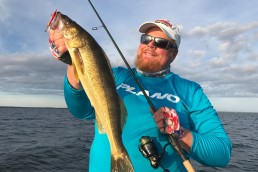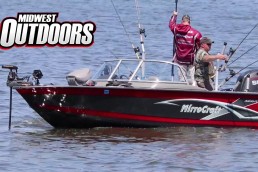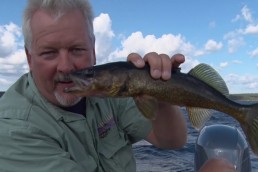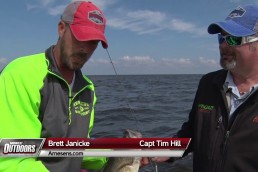Fall Walleye Fishing Made Easy
SHARE THIS POST
The changing seasons are one of the best things about living in northern Minnesota. Fishing patterns go in the opposite direction in the spring and fall, with most fishing patterns driven by water temperatures. Most fall fishing patterns become a reversal of the spring fishing patterns, like the unwinding of a clock.
The fish will do similar things, as the water temperatures drop between 70 and 60 degrees in the fall, as they did in the spring when the temperatures were rising between 60 and 70 degrees. Same thing when the lakes cool down between 60 and 50 degrees, right down until the lakes are at 40 degrees and ready for winter.
September is one of my favorite months of the year because it finally starts to cool down. I don’t particularly enjoy hot, sweaty weather when I am guiding.
September is also one of the better fishing months of the year, with great fishing for all species. The scenery on the lakes in the fall also needs to be mentioned, because it can be spectacular, almost like fishing inside a postcard.
Nothing to grouse about in fall hunting
Grouse hunting also opens in September. It’s one of my favorite fall activities, along with fishing. It gives me the chance to do a little “Minnesota Surf and Turf.” Grouse hunting in the morning and fishing in the afternoon… who could ask for anything more!
The dinner bell is ringing!
The falling water temperatures during September trigger a feeding movement in the fish. The fish know winter is coming. They feel the need to put on some weight before the cold temperatures arrive.
It’s time to get fat and sassy for the fish, so they can go through their fall growth spurt that is fueled by their heavy feeding patterns in the fall.
The young-of-the-year minnows have grown-up over the summer to become viable forage, so the larger fish start eating them like popcorn. There is plenty of forage in the lakes in the fall. Fish have an easy time gorging themselves and putting on some weight before winter.
I have cleaned many walleyes, late in the season, that had so many minnows in their stomach that I couldn’t believe they could have fit even one more minnow when they hit my lure or ate my jig.
Presentations that please our piscine companions
My two favorite fall presentations for walleyes and crappies are a jig and minnow or a Northland Puppet Minnow. Both presentations are very effective. I will have rods rigged with both presentations.
Puppet Minnows are reaction lures. Fish will come flying in to see the lure and try to time the pauses between jigging motions to hit the lure. Pausing between jigging is important because it is when most of the strikes occur.
Many anglers fish Puppet Minnows vertically, but they can also be cast when the bottom conditions are right. I like to cut off the front hook on the Puppet Minnows I use for casting. That way, they don’t snag things on the bottom nearly as often.
I leave a little of the base of the hook on the Puppet Minnow when I cut off the hook. It acts like the wire on a bottom bouncer to deflect the lure slightly when it hits a rock or some other obstacle on the bottom.
Are you enjoying this post?
You can be among the first to get the latest info on where to go, what to use and how to use it!
Perfecting the presentations
Casting Puppet Minnows takes some finesse. You can’t let it crash into the bottom and just lay there. You have to keep it moving and anticipate when it will hit the bottom. You can give it a little sweep and keep the proper motion going. I will finish each cast by working the lure under the boat to catch some of the fish that follow the lure to the boat.
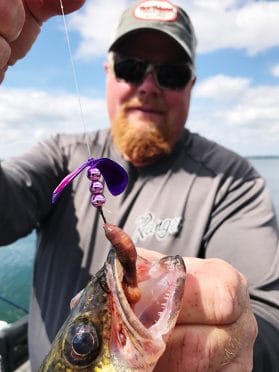
I like to use a 7-foot, medium-action St. Croix Legend Elite with a fast tip for casting or jigging Puppet Minnows. I spool up with 10-pound-test Northland Walleye Braid and about 20 inches of 8-pound-test Sunline FC Sniper Fluorocarbon leader with a small swivel to connect the two pieces of line and a snap to connect the leader to the jigging lures.
I like to keep the leader short enough so I can cast without too much line out and so I don’t accidentally reel the swivel into my rod guides. The swivel helps take out some of the line twist that naturally occurs when fishing a jigging lure. The snap lets me change colors quickly, without having to cut the line.
Becoming irresistible to fish
The presentation works best on unpressured fish that haven’t seen the lure. But, some fish don’t seem to be able to resist the lure when an angler gets the proper cadence going.
I use the larger-size Puppet Minnows for walleyes and the smaller sizes for crappies. Both species love the Puppet Minnows and fishing them can become addicting, so be warned.
Anglers need to be careful with the sticky sharp hooks on a Puppet Minnow. Have a long needle-nose pliers handy. Some of the fish will inhale the lure so far down, you can barely see it.
You really don’t want your fingers anywhere near those hooks. Cutting off the front hook also helps when unhooking fish. Also have a hook cutter in the boat, just in case a more delicate extraction needs to be performed.
Walleyes and crappies sometimes like the more aggressive jigging when they first see a Puppet Minnow at a distance, but want something more subtle when they get close.
Check your technique with a powerful sonar unit
Anglers need to figure out a good closing move on the fish. I have an Aqua-Vu HD7 Pro mounted to the side of my boat. I can see the size and species of fish under my boat. I can also use it for vertical jigging, which can be a huge advantage.
When vertically fishing crappies, other people in my boat can bring their Humminbird Ice Series Sonar units (I like the Ice7), so they can hang the transducer over the side of the boat and see their lures and the fish in real time.
Just don’t forget to remind the other anglers to pick up their transducers before you take off in the boat. You could end up with dings in your gelcoat, or you might find out that portable sonar units don’t float.
Brian “Bro” Brosdahl is a fishing guide and promoter who lives in Max, Minnesota with his wife Heather. He can be booked for guided trips on Cass Lake, Leech Lake and Lake Winnibigoshish, or for speaking engagements at bbro@paulbunyan.net or brosguideservice.com. Follow him on Instagram, Twitter and Facebook.
MWO
SHARE THIS POST
Did you enjoy this post?
You can be among the first to get the latest info on where to go, what to use and how to use it!
Brian 'Bro' Brosdahl
Outdoor communicator Brian “Bro” Brosdahl lives in northern Minnesota. He is a walleye guide in the Cass Lake, Leech Lake and Lake Winnibigoshish areas. He is sponsored by Northland Fishing Tackle, Frabill/Plano, Aqua-Vu, Humminbird/Minn Kota, St. Croix Rods, Ranger Boats, and Evinrude. Guide inquiries: brosguideservice.com. Follow on social media.
